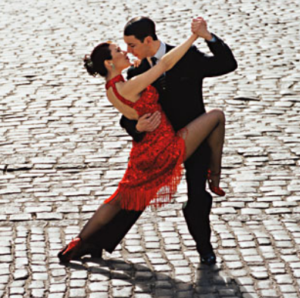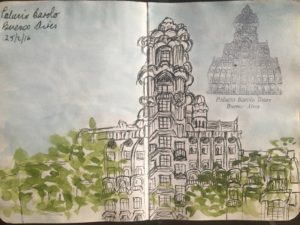Well since I’ve been locked down at home now for about a week, there’s not a lot happening, and certainly nothing work posting about in the blog. So I decided to take this chance to write a bit about Argentina. Although my friends have heard me rave about this country for several years, and I’ve blogged a bit about my travels and other adventures, I haven’t actually said a lot about the country itself. I’m going to do more posts like that from time to time, and I thought I’d start — naturally — with Buenos Aires.
“Argentines are Italians who speak Spanish and think they’re French.”
So goes a well known saying here, and it’s particularly noticeable in Buenos Aires, the capital of Argentina. Italian and French influences are both strong, but in different ways. Today I’m going to talk about the Italians in Argentina and in another post I’ll deal with the French.
Immigration
The first wave of immigration from Italy took place around 1880-1920, round about the same time as Italians were also flocking to New York City. Both groups were looking for a better life, and they profoundly influence both cities.
Food
 I’ve never met anyone who doesn’t like Italian food, but it seems that each country puts its own spin on it. Buenos Aires, for example, is bonkers about pizza. One of the main streets is Avenida Corrientes, and there’s a long stretch that seems to have a pizza place on every corner and some in between. Argentines love cheese, and the more the better, so the pizza here tends to not only have a thicker, more doughy crust, but enough cheese to make a gooey covering that strings out much like the cheese on French onion soup.
I’ve never met anyone who doesn’t like Italian food, but it seems that each country puts its own spin on it. Buenos Aires, for example, is bonkers about pizza. One of the main streets is Avenida Corrientes, and there’s a long stretch that seems to have a pizza place on every corner and some in between. Argentines love cheese, and the more the better, so the pizza here tends to not only have a thicker, more doughy crust, but enough cheese to make a gooey covering that strings out much like the cheese on French onion soup.
Personally, I like the pizza here, but if you are a fan of the thin crust, it may not be your favourite.
Porteños, which is what the natives of Buenos Aires are called (as well as folks like me who have taken the country to their hearts and happily call themselves Porteños too), also have an ongoing love affair with ice cream. Since Italians are also world famous for the ice cold treat, it seems natural they would bring the taste here.
The ice cream tends more towards the Italian gelato than the creamier North American type, but not all the way. Somehow, Argentines have found something halfway between the two which seems to me more delicious than either.
There are so many ice cream shops in Buenos Aires you’d wonder how they all stay in business — except that they all seem to be buzzing day and night! There’s one in Olivos, where my friend Cecilia stays, called Arnaldo’s. We went there one night around midnight, and had to line up just to get a table! Whole families, complete with kids and dogs, were there eating ice cream!
Language
Anyone who speaks Spanish will tell you that the version spoken in and around Buenos Aires is different from the rest of the Spanish speaking world. It’s usually called Castellano rather than Español, and has a definite Italian lilt to it. Not to mention that Porteños speak with their hands just as Italians do. As Buenos Aires sits on the River Plate, the dialect is called RioPlatense, and it’s also spoken in Uruguay on the other side of the river.
There is also a totally incomprehensible (at least to me and most expats) slang here called lunfardo. It apparently originated among Italian immigrants in the working class barrio of La Boca. The story goes that it was created to flummox the police, who couldn’t understand what anyone was saying!
Tango
 And of coure for me, the best gift the Italians brought to Argentina was the tango, which also originated in La Boca. My tango teacher told me that the close embrace that so characterizes tango was the only way many single men, who had left their families back in Italy, could enjoy close physical contact with another person. However it started, I’m sure glad it caught on!
And of coure for me, the best gift the Italians brought to Argentina was the tango, which also originated in La Boca. My tango teacher told me that the close embrace that so characterizes tango was the only way many single men, who had left their families back in Italy, could enjoy close physical contact with another person. However it started, I’m sure glad it caught on!
Architecture
 Buenos Aires is full of magnificent old buildings that originally housed wealthy families and are called palacios. One of the most striking, though, was actually built as an office building, which it continues to be today. Palacio Barolo was designed by the Italian architect Mario Palanti and opened in 1923.
Buenos Aires is full of magnificent old buildings that originally housed wealthy families and are called palacios. One of the most striking, though, was actually built as an office building, which it continues to be today. Palacio Barolo was designed by the Italian architect Mario Palanti and opened in 1923.
The building has 23 storeys, each representing a stanza of Dante’s Divine Comedy. And as the architect was a Freemason, there is also a great deal of Masonic symbolism in the building.
I took a tour of Palacio Barolo on one of my previous visits. This is a sketch I did from the door of a shop across the road.
This has been a very general overview of the Italian influence on Buenos Aires, and I hope you found it interesting and learned something new about my beautiful adopted city. If you have any questions, ask them in the comments and I’ll try to answer them if I can.
My next post will talk about the French influence.
